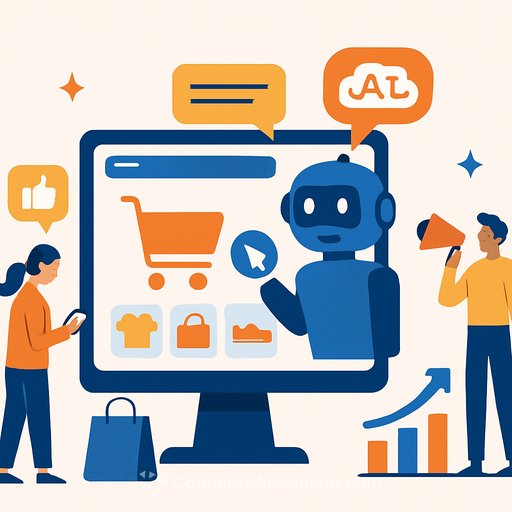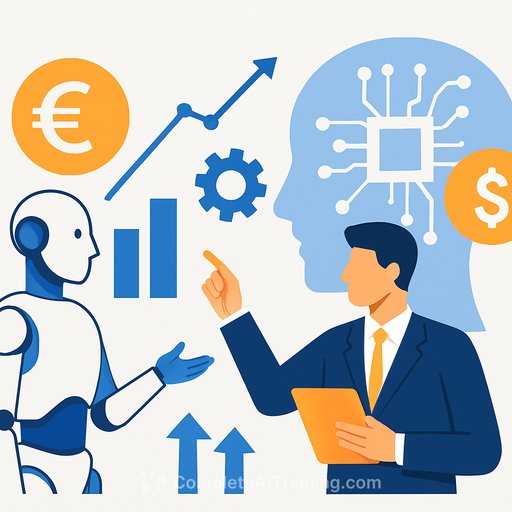Why Generative AI in eCommerce Matters More Than Ever
eCommerce has hit a turning point. Traditional methods no longer satisfy modern shoppers who expect personalization, instant replies, and smooth experiences at every interaction. Generative AI solutions meet these demands head-on.
Data shows companies investing in AI see a 3 to 15% boost in revenue and a 10 to 20% jump in sales ROI. But the change goes beyond numbers. Nearly half of Gen Z begins product searches on social media rather than Google, and 47% use generative AI weekly. This generation expects AI-powered engagement as the norm.
B2B companies are outspending B2C in generative AI for eCommerce, dedicating 11-25% of their ecommerce budgets compared to less for B2C. Early adopters aren’t just testing—they’re scaling AI across operations.
How Does Generative AI for eCommerce Marketing Work? It’s All About the Models.
Generative AI in eCommerce runs on advanced AI models trained on large datasets. These models learn data patterns to generate original content—human-like text, realistic images, designs, and smart conversations.
Key model types include:
- Large Language Models (LLMs): Like GPT-4 and Google's Gemini, these handle natural language tasks—customer service chats, marketing copy, and more.
- Generative Adversarial Networks (GANs): Two neural networks working together to produce realistic product images and even virtual try-ons.
- Diffusion Models: Used for high-quality image and video generation by refining noise into clear visuals.
These models help automate tasks, personalize customer interactions, and generate actionable insights from massive data.
Generative AI Applications in eCommerce and How It Is Transforming the Industry
Generative AI’s impact in eCommerce spans many areas. Here are key use cases changing the way retail operates:
Hyper-Personalized Customer Experiences
Generative AI can customize websites dynamically based on the visitor’s behavior and context.
Example: Amazon’s AI offers contextual recommendations, like showing “Gift boxes in time for Mother’s Day” based on browsing history, seasonality, and shopping times.
Automated Product Descriptions and Content Generation
Creating product content is faster with AI. Sellers can generate detailed listings in minutes instead of hours.
Example: eBay uses generative AI to automate millions of product descriptions efficiently.
AI-Powered Visual Search
Visual search allows customers to upload images or use their cameras to find similar products or styling ideas.
Example: Perry Ellis partnered with Syte for AI-driven clothing search and recommendations.
Predictive Inventory and Supply Chain Optimization
AI forecasts demand by analyzing many variables, helping manage stock levels smartly.
Example: Walmart uses generative AI to adjust inventory based on customer intent and engagement, reducing stockouts and overstock.
Intelligent Customer Support
Generative AI chatbots understand customer queries and provide helpful answers quickly.
Example: DoorDash’s AI system cut agent transfers by nearly 50% and improved first-contact resolutions.
Immersive Shopping Experiences
AI powers AR/VR features that blend online and offline shopping.
Example: Wayfair’s Decorify tool shows how furniture looks in different room styles using spatial computing.
Hyper-Targeted Marketing Campaigns
AI-driven marketing automation creates thousands of personalized campaigns tailored to audience segments.
Example: Nike delivers content that resonates with individual customer preferences.
Advanced Fraud Detection and Cybersecurity
AI detects suspicious transaction patterns and behavior in real-time to prevent fraud.
Example: PayPal leverages AI to monitor transactions and block fraudulent activity.
Product Design and Innovation
Companies analyze customer feedback and trends to develop products that meet actual demand.
Example: Unilever’s interactive tool provides personalized haircare recommendations based on user profiles.
Dynamic Pricing Optimization
AI adjusts prices continually considering various factors to maximize objectives like sales or profit.
Example: Uber uses AI-driven surge pricing that adapts fares in real-time based on supply and demand.
Scalable Customer Insights and Analytics
Generative AI automatically summarizes data, spots trends, and suggests strategies for decision-makers.
Example: Netflix applies generative AI to optimize content discovery and understand viewer preferences.
How to Implement Generative AI Solutions in eCommerce Operations
Implementation can feel overwhelming. The key is to start small and focused:
- Phase 1: Pick Your Pain Points — Identify one area where AI can quickly add value.
- Phase 2: Get Your Data House in Order — Clean and organize customer, product, and transaction data.
- Phase 3: Start with a Pilot Program — Test AI on a small group of customers or products.
- Phase 4: Integrate with Existing Platforms — Ensure smooth AI integration with current systems.
- Phase 5: Scale What Works — Expand AI solutions once ROI is proven.
Cost of Implementing Generative AI in eCommerce
Costs vary by scale and approach. In 2024, organizations spent an average of $110 million on generative AI projects. Small and medium businesses typically invest between $40,000 and $400,000 initially.
Returns improve quickly, with companies often seeing 3.7x ROI on AI investments.
Future of Generative AI in eCommerce
- Multimodal AI: Enabling shoppers to interact via voice, text, and images seamlessly.
- Agentic AI: Autonomous AI agents managing complex tasks independently.
- Voice Commerce: Natural conversations with AI assistants becoming standard.
- Predictive AI: Anticipating customer needs before they express them.
- Sustainable Commerce: AI optimizing operations for environmental impact.
What Makes Appinventiv Your Ideal Partner for Integrating Generative AI in eCommerce?
Choosing the right partner for generative AI integration is critical. Appinventiv offers experienced teams and a solid track record delivering generative AI solutions tailored for eCommerce.
FAQs
Q. How does generative AI enhance eCommerce personalization?
A. It creates unique shopping experiences by analyzing individual behavior, preferences, and context to tailor content and recommendations.
Q. How is AI changing eCommerce product creation?
A. AI automates product content generation, creates visual assets, and supports market-driven product development.
Q. How to implement generative AI effectively in eCommerce?
A. Focus on key pain points, prepare data, run pilot programs, integrate with existing platforms, and scale successful solutions.
Q. How is generative AI transforming eCommerce operations overall?
A. Through applications like personalized experiences, automated content, predictive inventory, intelligent customer support, and more.
Your membership also unlocks:






